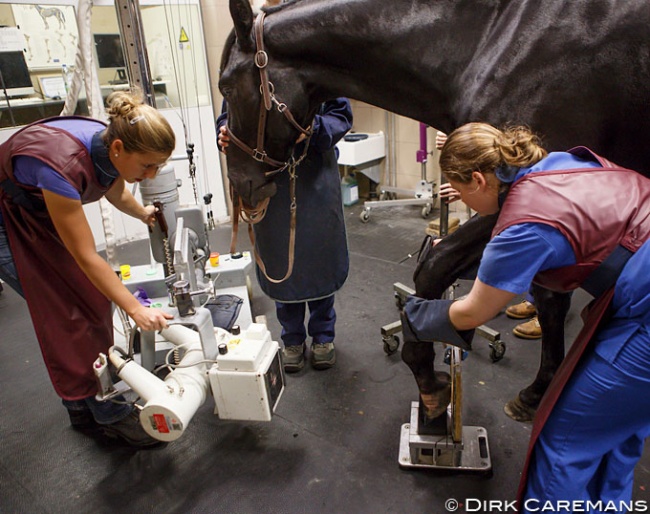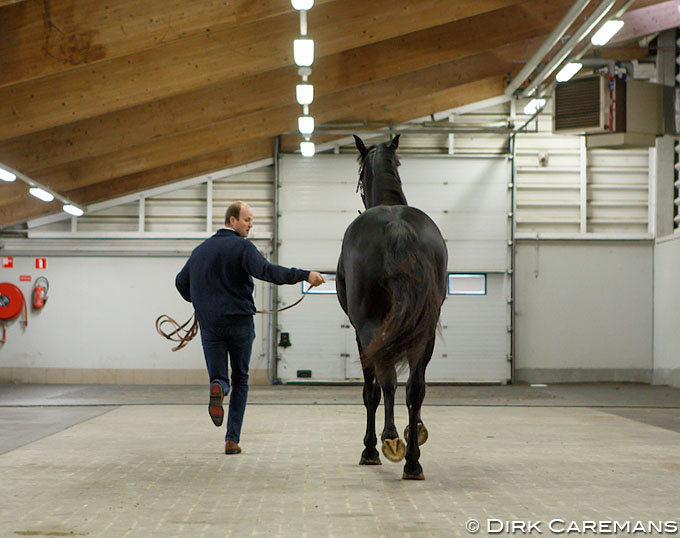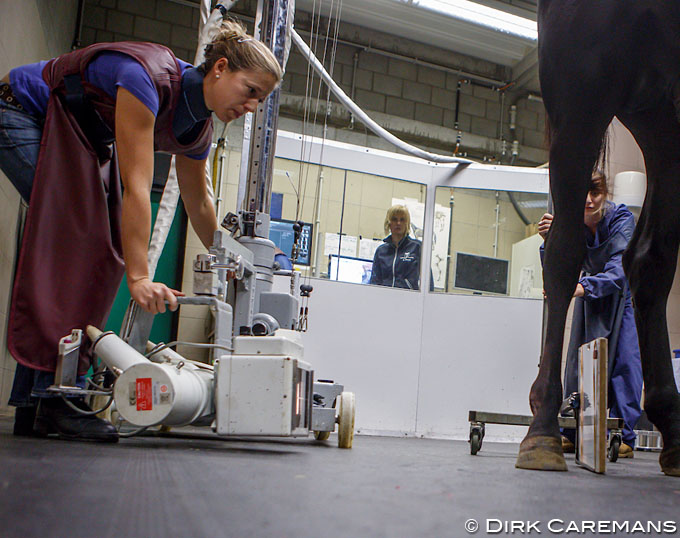
By Dr Maxine Brain BVSCc, MACVSc
Hearing your horse has failed the vet check is no reason to throw yourself off the nearest bridge. However, the potential buyer may no longer be interested in your horse. Frustrating as it sounds, there are still many options open to you and potential buyer – provided the horse doesn’t have a major issue you've been hiding.
Understanding the Pre-Purchase Examination (PPE) is paramount to understanding what to do after you have been informed the horse was not suited to the potential purchaser (PP). First, it should be noted that a PPE is basically a contract between the veterinarian and the PP. Legally, the information gained from the examination belongs to the purchaser and cannot be given to the vendor unless the purchaser gives permission for it to be shared. For this reason it is a good idea to be present at the time of your horse's PPE, as you may gain an insight into any issues with your horse.
The PPE can take many different formats, which should be discussed between the veterinarian and PP before the examination is conducted. Factors to consider in the PPE include but are not limited to: the purpose for which the horse is to be used, the current use, the cost, the expectations and the experience of the purchaser. There is no point in having a PPE done on a horse that has been retired from competition by a career-ending injury and expecting it to be passed as a suitable competition horse. It is also important to note that it is not always practical to expect a full examination on a horse that isn’t broken in, or to have a horse work at maximum capacity when it’s been in a paddock for three months. Although the price of the horse should not influence the quality of the PPE, it is important that the PP is well informed of the potential costs involved in examining a horse as it is not practical to spend $2000 on a $1000 horse (it is the PP's right to spend whatever they want to, however, it is important these costs are pointed out to them prior to embarking on a three-hour veterinary examination).
Generally, the PPE will include a full clinical examination, including auscultating heart, lungs and gut, checking eyes and mouth for major abnormalities, and checking the body and limbs for abnormalities. The horse should then be trotted out in a straight line to check for lameness or gait abnormalities. This stage is dependent on the temperament and stage of education of the horse as well as the environment in which the examination is being conducted. Unbroken horses may only be able to be observed running freely in a paddock if they have not been taught to lead. Legs should be flexed to check for evidence of pain or restricted limb movement (once again, this depends on the temperament and education of the animal).
Most PPEs will involve the practice of flexion tests. This is generally where the veterinarian will flex a limb for a designated time before allowing the horse to trot off immediately and then assess its action. This can provide the veterinarian with some vital information but can also be controversial to some, particularly when the vendor or PP interprets the results as “he failed the flexion tests!” Flexion tests are designed to exacerbate lameness issues so they can be detected.
It is extremely important that the veterinarian be consistent on the time and degree of flexion of each limb. Not all veterinarians need to flex for the same period of time or with the same degree of strength, but each needs to apply the same time and pressure between limbs so that any abnormalities highlighted can be interpreted correctly. For example, if both front fetlocks are flexed in a similar manner, and the horse goes lame on one limb and not the other, this is usually significant. However, if one limb is lightly held for 20 seconds and the other limb is forcibly flexed for 60 seconds, the difference in response is irrelevant, in my opinion. Likewise, if a horse is positive on all four flexion tests but shows no evidence of lameness in any other aspect of the PPE, or has no abnormalities such as swollen joints, then the relevance of the flexion test should be questioned. The horse is then often worked or lunged to complete the clinical examination.
Other options available to the PP are ancillary tests such as radiographs, ultrasounds, endoscopy and blood tests. These tests are generally reserved for more expensive purchases, or when a potential problem has been identified which the vet believes warrants further investigation.
So why do horses “fail”? Firstly, the practice of “passing” or “failing” a horse is a very contentious issue. Some veterinary practitioners are happy to give their opinion as to whether they believe the horse should be bought or not. They believe they are being paid for an opinion and that they should therefore make that decision. Other practitioners believe that they should present the facts and their interpretation of them and allow the purchaser to make the decision. My personal approach is in line with the latter group in that I do not pass or fail the horse, just present everything and allow the purchaser to decide. Why do I prefer this approach? I believe it is fairer on both the purchaser and the vendor because the purchaser is given the information on which he or she can make a decision based on what they want out of the purchase.
The veterinarian should be informed about the type of work and how much work the horse has had in the weeks leading up to the PPE, as the interpretation of the results can be affected by the workload or exercise level the horse is at when examined. A horse that is out of work may not display evidence of lameness, even though it has some clinical evidence of potential problems because it has been rested (only to show the recurrence of an injury once it is back in full training). Sometimes a horse in full work may show signs of soreness immediately following a hard workout, which are only temporary issues and not indicative of a career-threatening injury.
It is easier to see the options available to the vendor if the horse does not sell by addressing some of the reasons why a horse may fail or be given an unfavourable report.
1) The horse has a major issue that would significantly affect its ability to perform the duty for which it was being purchased.

2) The horse may have a temporary issue which affected its performance on the day.
Example: the horse may have pulled off a shoe the night before the examination. Similarly, it may have hit its eye and have an ulcer which can prevent the horse being given the all-clear. Ideally, postpone the PPE until the temporary issue is sorted. If the examination can’t be postponed, then the vendor, PP and veterinarian can discuss the possibility of doing the majority of the examination on one day and completing or re-examining the horse another day when the temporary issue has resolved. If an issue arises between the two examination dates, it may not be noted on the pre-purchase report unless the veterinarian repeats that stage. In the case of the horse that lost its shoe, the clinical examination can be done initially and the trot-outs and flexion tests done a few days after the horse has been reshod.
3) The horse has been inadequately prepared for the PPE.
Occasionally a horse is presented for a PPE and the results are compromised because the horse has not been prepared for the examination. Things such as poor fitting, loose or lost shoes, cracked hoof walls or being trimmed back quite short the day before can result in the horse being footsore on the day. This can extend to the situation where a horse is subjected to a major change in workload in the period leading up to the examination. A horse that is given an intense week of jumping, when it has never been taught to jump before, will often show muscle soreness which can mimic a sore back. This can be one of the drawbacks of allowing a PP to have a horse for a trial period before they decide to buy the horse. Some purchasers try to do everything with the horse in a very short period so they can see what the horse is capable of. Consequently, when the horse is examined by the veterinarian, the PP can be given a poor report because the horse is sore all over simply because it has been overworked.
4) The PP has unrealistic expectations of the horse.
Some purchasers are looking for the perfect horse, which rarely, if ever, exists. Unfortunately, they do not understand that a horse is an animal and not a manufactured robot without a blemish. Their interpretation of any anomaly mentioned in the veterinary report is that the horse has a problem that they are not prepared to accept. Others have expectations that the horse they purchase now should be perfect for the next 20 years and are looking for some guarantee from the vet. A PPE is a report on the status of the horse at a point in time; it is not a guarantee of suitability for the life of the animal. From the vendor's standpoint, this is not a major issue as the failure of the sale and is not to do with the horse but rather an unsuitable purchaser. There is often another PP with more realistic expectations so the vendor just needs to continue to advertise the horse for sale.
5) Previous experiences the PP may have had with buying or owning a horse.
Example: an owner who has had a horse with a “sore back”. If they have had success with managing a back ailment on a previous horse then they are not worried by the purchase of a horse that may require management of a back issue in the future. Another PP may have not been able to manage such an issue and so the prospect of buying a horse with a potential back issue is not appealing. The vendor in this case can either consult their veterinarian to see if there are options available to improve or rectify any clinical abnormalities.
6) The PP doesn’t want to pay the price the vendor is asking.
Sometimes the purchaser will try and use the results of the PPE to negotiate down the price of the horse. There may be legitimate reasons for this if they believe there are issues that make the horse less valuable, and sometimes the vendor may need to reduce the asking price if the horse cannot be used for the purpose the PP requires. However, there may also be times when the PP is simply trying to get a better deal and using the PPE report to do this. I do not believe it is the role of the veterinarian to determine the value of a horse and the vendor and PP should both seek their own independent advice as to what the horse is worth based on all the criteria the sale is based upon.
In summary, the following points should be highlighted:
- The PPE is a contract between the veterinarian and the PP and all information gained from the examination belongs to the PP.
- The veterinarian is there to identify flaws or potential flaws with the horse and to discuss with the PP any issues found and risks associated with them.
- The PPE is a report on the status of the horse at a given point in time and the results may vary if there is a significant time period between examinations.
- If a horse does not “pass” the examination the vendor should seek the opinion of their veterinarian as to how they might deal with the issues raised.
- A horse that is not purchased by one buyer because of an issue identified by the veterinarian may be bought by another purchaser who is happy to accept the horse as is.
- A vendor may have to reconsider the purpose for which the horse is being sold if a problem is identified which will significantly negatively affect the ability of the horse to perform that career.
- Although the PPE may be used by the PP to negotiate a cheaper price for the horse, the vendor and the PP should seek their own independent advice as to the value of the horse.
Just a note for vendors to think about, be very careful about what you post on social media regarding “Failing the Vet Check”. Often the only message that is perpetuated is that the horse failed, and that information tends to spread like wildfire. Then, unfortunately, the reason why the initial PP didn’t buy the horse becomes irrelevant as future purchasers are biased against the horse because they have the impression that the horse has a problem. It is far easier to identify the reason why the PP didn’t buy the horse. If possible, work to improve these issues and concentrate on finding a new buyer that better suits the horse.
Anti-arthritic medications

Until stress is placed on one limb individually as happens with a flexion test, the horse shows no overt evidence of lameness. Whilst the PP may not want to purchase a horse once this potential problem is identified, it is not all bad news for the vendor as often the use of certain joint supplements can help these low-grade joint issues and alleviate the symptoms of soreness. This improvement is achieved without having to use drugs such as phenylbutazone or corticosteroids.
There are many of these joint supplements or “anti-arthritic” type products on the market. Most are based on glucosamine, chondroitins or hyaluronic acid type products and can be injected or orally administered. Polysulphated glucosamines (for example, pentosan, cartrophen and arthropen) are available as injectable preparations that are given weekly initially then monthly as a maintenance dose. They are believed to promote synthesis, repair and maintenance of healthy cartilage as well as provide an anti-inflammatory effect on the joint.
Chondroitins are usually derivatives of cartilage products or shellfish and are marketed as dietary supplements. They are believed to stimulate the production of proteoglycans and hyaluronic acid, both important in joint maintenance and function, as well as decrease the breakdown of cartilage by cell types in the joint.
Hyaluronic acid helps with the lubrication and mobility of the joint as well as providing some anti-inflammatory properties. It is available as both an oral supplement and an injectable. While the glucosamines and the chondroitins require a longer time before positive clinical signs are seen, the hyaluronic acid is reported to act more quickly and show positive clinical signs earlier. The use of all three products at the same time is thought to have a synergistic effect, meaning that the response is superior.
By Dr Maxine Brain BVSCc, MACVSc
This article was first published on Equestrian Life. Reproduced with kind permission
Photos © Dirk Caremans
Related Links
Legal Letter: Your Duty to Investigate When Buying a Horse
Legal Letter: Equine Lawyer Stephan Wensing on Latent Defects
Legal Letter: Deviation or Deception
WBFSH Vet Group Meeting in Bargteheide on Harmonization X-rays
2019 EUAEL International Equine Law Congress: Will Your Horse Survive the Pre-Purchase Exam?